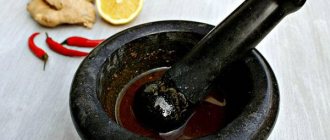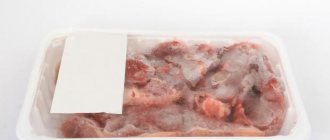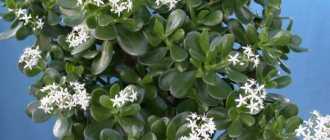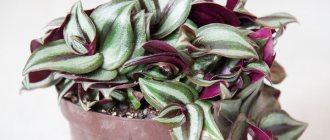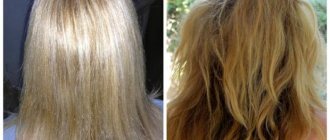Before using the berries, you need to carefully study the benefits of nightshade and what harm it can cause to the body. Nightshade is useful for severe pain, as it has antispasmodic and analgesic properties. In folk medicine, it is often used to improve the functioning of the digestive system, lungs, hearing and smell organs, and for skin damage. Nightshade is a fairly diverse plant. Both its appearance and its scope of application are varied. Nightshade can be found as a tree with a creeping, straight or recumbent stem, as well as as a herb and shrub. The formula of the black nightshade flower is H (5) L (5) T5 P1.
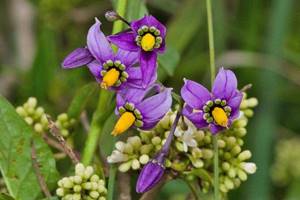
On this topic:
Berry mosaic on the window – indoor nightshade
Oct 18, 2018
Chemical composition
The chemical composition of nightshade is so rich in chemical microelements that it has not yet been fully studied.
Known components of black nightshade according to classification:
- Lobed nightshade contains large quantities of the components solasonin and solamargine.
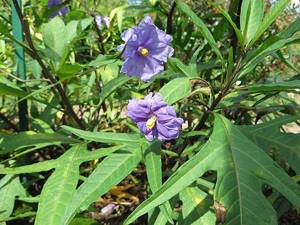
- The bittersweet nightshade variety contains solacein and solanein.
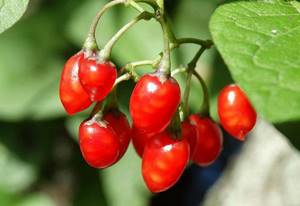
- Black nightshade contains solasonine, solamargine and sola-sodamine. These microelements have extremely toxic properties for humans. All toxic properties are completely neutralized after the fruits of the plant ripen.
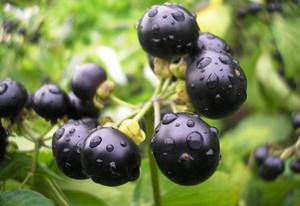
What are the benefits of nightshade?
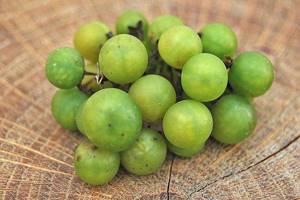
However, the plant is included in many medicinal preparations. Nightshade is also actively used by traditional healers. Nightshade has the following medicinal properties:
- calming;
- painkillers;
- blood purifying;
- vasodilator;
- increases blood clotting;
- diuretic;
- expectorant;
- improves metabolism.
In addition to the beneficial properties of black nightshade, there are also harmful properties. Therefore, before use, you must read the list of contraindications.
https://www.youtube.com/watch?v=inVK6J23FFE
Benefits and harms
Nightshade “Black” is poisonous, so it will harm anyone who decides to use any parts of the bush or unripe berries for food. But among herbalists, black nightshade is held in high esteem because it is used to prepare medicinal infusions, lotions and other similar products. The plant is not used in traditional domestic medicine.
Some housewives prepare jams and a filling for baking from ripe nightshade berries.
REFERENCE! Properly prepared for subsequent use, the plant retains its beneficial properties for at least 5 years.
Poisonous or not?
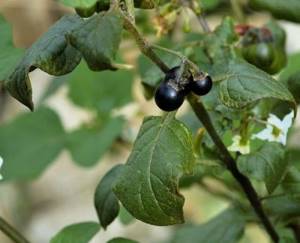
Nightshade "Black" is poisonous.
Indications for use
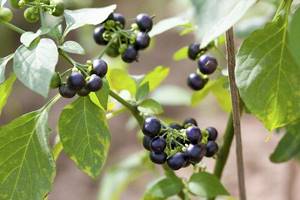
Nightshade copes well with many diseases of the digestive system and some kidney diseases. Often, preparations with nightshade are prescribed for cholecystitis and pyelonephritis. The plant is also effective for neuroses, epilepsy and skin diseases.
Nightshade herbal juice has a blood purifying effect. It is good to use in the presence of boils, lichen and allergies.
Nightshade has an expectorant effect, and therefore is good for dry coughs, bronchial diseases and tuberculosis.
Sunberry (Blueberry Forte, Crowberry, Sunny Berry)
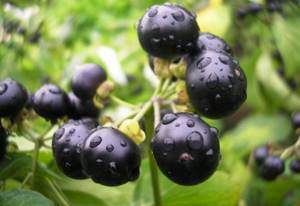
Sunberry is a new crop in our area and is still very rare, although its more than close relative - wild black nightshade - is very familiar to everyone as a weed. As a matter of fact, sunberry is a cultivated hybrid form of this unpleasant weed, with the difference that its berries are not only non-toxic, but are even good for health - they have many healing properties, in addition, they are larger and more numerous.
Biological features of sunberry
Sunberry is an annual herbaceous plant with a bush reaching 1.5 m in height. The stem is powerful, fleshy, tetrahedral, and forms a large number of stepsons. The leaves are the same as those of black nightshade. The flowers are white, star-shaped (like those of nightshade or potato), collected in an inflorescence-brush with an average of 10-20 pieces. It blooms until late autumn; as soon as some flowers begin to bear fruit, the next ones bloom. The berries are the same in shape as those of black nightshade (miniature black “tomatoes”), the size of a cherry (1.5-2 cm in diameter), and do not ripen simultaneously (until late autumn). At the moment of the most massive ripening, it seems that the bush is completely strewn with them.
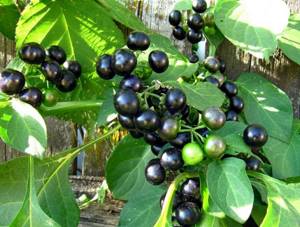
Sunberry is very unpretentious and bears fruit well in bad weather conditions, under which other berries do not ripen.
Sunberry value
Sunberries can be eaten fresh, but not everyone likes their nightshade flavor, so they are much more often used for processing. This taste can be partially removed by pouring boiling water over the berries, leaving them for several minutes and draining the water. After this, they can be processed into juice (from which a special wine with healing properties is also prepared) or jam, which in Western countries is highly valued for its original taste.
Sunberry juice diluted 1:1 with honey (300 g of honey per 1 liter of juice) normalizes blood pressure, increases endurance, relieves or completely eliminates headaches, and is also useful for stomach ulcers, rheumatism, hepatitis and asthma. Juice mixed with raw eggs is used to make lotions to treat eczema, psoriasis and seborrhea.
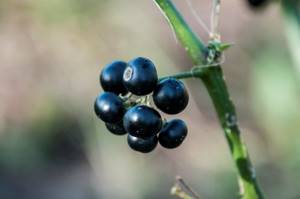
The leaves and stems also have medicinal properties (however, do not forget that, like all nightshades, they are poisonous, and therefore their use requires great caution). An infusion of crushed dry leaves is taken for gastritis, colitis, cystitis, neurosis, hypertension, various convulsive conditions (including epilepsy), neuralgia, as a sedative, as well as for bronchial asthma and many skin diseases. During the mass ripening of berries, the sunberry bush looks very original and decorative.
Sunberry planting and care
For sunberry, it is better to allocate warm, sheltered from the wind areas on an elevation with good lighting; sandy and loamy soils with a pH of about 6 are optimal. Since sunberry is an annual, you can sow a couple of its bushes directly on the beds with vegetables. In this case, the best predecessors are cucumbers, onions and legumes; unacceptable - tomatoes, peppers, eggplants, potatoes (but sunberries can grow next to them).
The soil is treated as for garden crops. There is no planting hole. During autumn tillage, organic fertilizers are applied, and during spring tillage, mineral fertilizers are applied.
Sunberries are usually grown in seedlings. They can be sown in boxes at the same time as tomatoes—from mid-February to March. Seeds germinate at room temperature. The seedling boxes must have good drainage and water only with warm water. After germination, the box is placed in a warmer place if possible. Seedlings require additional lighting.
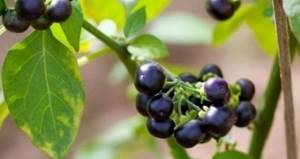
After the seedlings have grown stronger, they need to be planted, preferably in separate cups. Seedlings are planted in the ground after the end of spring frosts, when 6-7 true leaves have already formed. If you want to get your own seeds, it is better to select berries from clusters that ripen earlier than others (there is a chance of increasing early ripening).
Sunberry is very unpretentious and requires minimal care. It should be watered only when there is no rain for a long time. Other activities are also carried out only as necessary. Fertilizing is desirable, but not necessary on fairly fertile soil. The only specific feature is that the stepsons can droop to the ground under the weight of ripe berries, this should not be allowed, so you need to place slingshots under such branches or tie them to stakes.
Although annual pruning as such is almost never carried out, a similar action - regular plucking of flowers and buds, carried out in the fall (it should begin about a month before the onset of a steady cold snap) will increase the yield, since in this case new ones will not form ovaries that will not have time to ripen anyway. But those that have already started will have enough nutrients to form quickly and efficiently.
The harvest can be harvested all summer as the berries ripen. The remainder of the crop is completely harvested after the onset of sustained cold weather. Fresh berries are not stored for a long time, but they can be ground with sugar or processed into juice.
LiveJournal
Contraindications and harmful properties
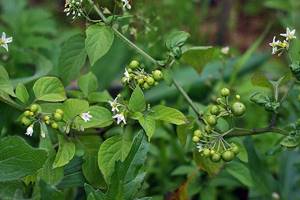
Black nightshade can be beneficial and harmful. The plant is poisonous, but not entirely. Only unripe nightshade berries are hazardous to health. Green fruits have a toxic effect on the body. This is due to the fact that unripe berries are rich in a poisonous glycoalkaloid. As it matures, its quantity decreases, and over time it disappears completely.
Nightshade is contraindicated:
- during pregnancy;
- during lactation;
- in childhood;
- with high blood pressure;
- diseases of the gastrointestinal tract;
- in case of personal intolerance to the plant (allergy).
The list of side effects after using nightshade includes the following symptoms:
- nausea accompanied by vomiting;
- diarrhea;
- chills;
- increased body temperature;
- increased sweating.
If side effects occur, you should immediately go to the hospital.
It is recommended to begin treatment with nightshade only after consulting a doctor. Nightshade is used in combination with other drugs. Nightshade alone will not provide complete treatment, but will only relieve some symptoms.
When using the plant, it is important to follow the dosage during preparation and consumption. Otherwise, you may experience the side effects described above.
Medicinal properties and contraindications
When used skillfully, the various parts of the plant:
- Relieves painful symptoms of migraines.
- Remove excess liquid.
- They drive out parasites and help the immune system resist the effects of malaria infection.
- Calms the nerves.
- They improve the separation of sputum in the bronchi, help the body fight whooping cough and tubercle bacilli.
- They reduce the symptoms of rheumatism, menopause, and ease the course of epileptic seizures.
- Promotes wound healing, relieves inflammatory processes in the bladder.
- Help fight bleeding and mycoses on the skin.
- Eliminates the tendency to constipation.
Any medicinal or food products prepared using any parts of black nightshade should not be taken:
- For allergy sufferers.
- For children.
- Pregnant.
- Nursing.
- Hypotonics.
- In violation of recommended standards.
First aid for poisoning
The victim needs to have his stomach rinsed and taken to the nearest medical facility as soon as possible .
Procurement of raw materials
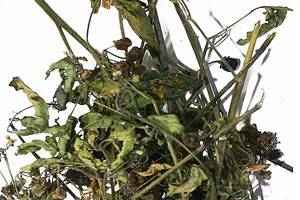
You can use young nightshade stems, berries and leaves as preparations. When harvesting nightshade stems, the procedure is as follows:
- Cut the stem, measuring 15-20 cm from the bottom.
- The cut stems and leaves of the plant are inspected for rotting, and damaged leaves are torn off.
- Place the nightshade in a place where the sun's rays do not reach. Also, the place should be well ventilated. Periodically turn the plant over until it dries completely.
Raw materials from black nightshade berries have been harvested since August. The procedure for this is as follows:
- Nightshade berries are collected along with the stem organ that holds the fruit.
- The berries are rinsed in cold water and left to dry.
- The berries are then separated from the stem organ that holds the fruit.
- The finished black nightshade berries are poured into a shallow container, having previously laid paper on the bottom. The fruits should not be too close to each other. Dry the berries in the shade, with good air circulation. Fruits must be turned over periodically.
- Fresh prepared fruits are placed on a metal sheet and placed in the freezer for 2 hours. Then the berries are taken out and poured into a bowl.
- The container with berries is filled with sugar in equal proportions. After a couple of hours, the fruits are crushed.
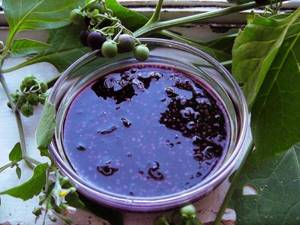
As an option, simply freeze the fruits of black nightshade for the winter. When frozen, nightshade will hardly lose its medicinal properties.
Is black nightshade poisonous?
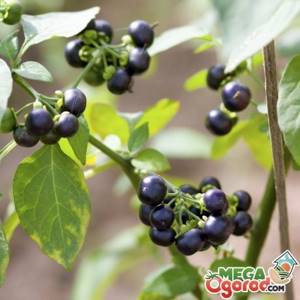
The annual plant black nightshade, or common nightshade, reaches a height of 70 centimeters. Its stem is erect and slightly pubescent. The leaves are on long petioles. They are either solid in shape or jagged along the edges. From June to September, small white flowers appear on drooping stalks, collected in umbrellas.
From July to early autumn, fruits appear on the stems - black, juicy berries, round in shape. While the fruits are green, they are poisonous. As the berries ripen, the toxic substance solanine loses its toxic effect. You can safely eat black fruits with a large number of yellowish seeds inside. The toxicity of nightshade is known to everyone, therefore, for medicinal purposes, the leaves and flowers are used under the supervision of a doctor. Black berries do not contain harmful substances, but you should not get carried away with their consumption.
All parts of the plant are poisonous, except for the ripe, juicy berries.
The warm regions of the Mediterranean are considered the homeland of black nightshade. Nowadays it can be found in abundance everywhere. On the banks of reservoirs and near roads there are bushes strewn with black berries. In gardens and fields, they try to get rid of nightshade like a weed. This unpretentious plant is found in southern Europe, Central Asia, the Caucasus, and Siberia. It grows well in poor soils.
Spreading by seeds, black nightshade fills vacant lots. It multiplies quickly and grows on sunny slopes. The plant is not afraid of cold winters, which is why it has spread to areas with a temperate climate. The annual plant is not found only in Kazakhstan due to the arid climate. Black nightshade grows everywhere, but few people know about the beneficial properties of the plant. A person passes by, not paying attention to the source of vitamins and microelements.
Drug recipes
In folk medicine, there are several good recipes for black nightshade.
Nightshade ointment
The ointment is effective for skin diseases of any origin. It is applied to damaged areas of the skin under a bandage and left for several hours:
- The collected nightshade grass is completely dried and finely chopped.
- Vegetable oil is added to the crushed grass in proportions of 1:4.
- The resulting paste is applied to the skin several times a day, leaving for 2-3 hours.
Infusion for gargling
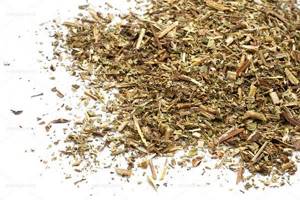
Effective for colds, sore throat, stomatitis and periodontal disease:
- First, squeeze the juice from fresh nightshade fruits.
- The juice is diluted with water in proportions 1:3.
- Rinse your throat and mouth several times a day for at least 4 minutes.
Remedy for rheumatism
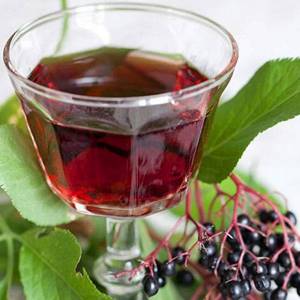
Recipe:
- 3 tsp The flowers of the plant are poured with 0.7 liters of hot water.
- The container is wrapped well and left for several hours.
- Then the infusion is filtered.
The product is used three times a day, one tablespoon.

